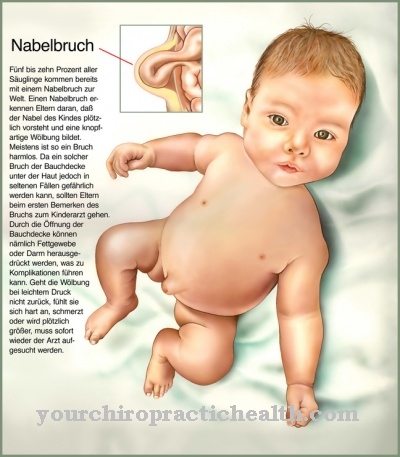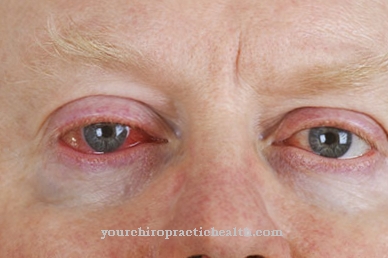Patients under the Eagle syndrome suffer from various complaints in the area of the throat and tongue. The reason for this is, for example, an atypically shaped and positioned styloid process (stylus process). The disease occurs mainly in women between the ages of 30 and 40.
What is Eagle Syndrome?

© Aleksej - stock.adobe.com
The disease Eagle Syndrome means "Eagle Syndrome" in German. The condition was first diagnosed in 1937 by Watt Weems Eagle, an ENT doctor. This is where the name comes from. Eagle syndrome often results in dull, neuralgia-like pain in the area of the side of the throat and tongue that radiate into the throat and ear.
Eagle syndrome is therefore characterized by pain in the throat, mouth, head, neck and face. The symptoms can be aggravated when swallowing. Patients with Eagle syndrome report that it feels like a foreign body in the throat that is accompanied by an obsession to clear the throat and swallow.
causes
In Eagle syndrome, the nerves between the stylus process and the hyoid bone are mechanically stimulated. Often there is also inflammation, usually periosteum inflammation. The following factors can cause irritation:
- Hyoid bone too long
- Elongated bone process behind the ear
- Insertion tendopathy (painful conditions caused by irritation of the tendon attachments)
- Calcified ligaments (hardened tissue)
Eagle syndrome usually occurs after injuries, surgery, or trauma to trimming. Diseases of the stylus process also result in recurring pressure on the cervical nerves and entrapment of the cervical blood vessels. The removal of the tonsils is also believed to be the cause of Eagle's syndrome.
You can find your medication here
➔ Medicines for sore throats and difficulty swallowingSymptoms, ailments & signs
Eagle syndrome is characterized by a deformity of the temporal bone. In this case, the stylus extension is more than 30 millimeters long. One of the most common complaints is a sore throat. The feeling of a foreign body that many people affected feel is very unpleasant. Pain in the throat and an aching pain in the tonsillar fossa are also common.
The sensation of pain arises particularly when swallowing and when moving the neck. Atypical facial pain is another common symptom. But there are also many people affected who do not have any noticeable symptoms. Typical symptoms of Eagle syndrome include:
- Unilateral pain in the area of the throat and throat
- Taste disorders
- Difficulty swallowing with a feeling of pressure or pain in the chest and upper abdomen
- Feeling that there is a foreign body in the throat area
- Swollen lymph nodes (chin, jaw, or neck)
- Slightly swollen neck above the hyoid bone
- One-sided cracking in the throat when swallowing
- Jaw pain
- Earache
- Joint pain
- Rheumatic complaints
- Changed voice
- to cough
- Dizziness and balance symptoms
- Changes in appetite
Diagnosis & course
The symptoms that occur in Eagle syndrome sometimes shift over months and sometimes they weaken somewhat. However, the clinical picture can be very persistent, so that there is seldom a real freedom from symptoms. Eagle syndrome often ends in chronic, permanent pain.
The diagnosis is usually made by an ear, nose and throat doctor, but the disease is not always recognized immediately, as the symptoms can also apply to various diseases. Scanning the tonsil compartment (area of the tonsils), computed tomography and an X-ray examination are the first measures that are suitable for diagnosing Eagle's syndrome.
In the case of Eagle syndrome, the imaging diagnosis reveals a stylus process that is atypically positioned, unusually long, bent medially or laterally. The stylus extension protrudes over its normal length of 30 millimeters. The examination methods may reveal limescale formation.
When should you go to the doctor?
If the typical deformity of the temporal bone is noticed, this should definitely be clarified by a doctor. In the case of facial pain, taste disturbances, swelling in the neck area and other typical symptoms of Eagle syndrome, a visit to a doctor is also recommended. Should complications such as dizziness and balance symptoms, changes in appetite or rheumatic complaints arise, this must be clarified quickly and treated if necessary.
People who have already suffered from periosteum inflammation are particularly at risk. Eagle syndrome can also occur after injuries, operations, or severe trauma. If you have these risk factors, you should see your family doctor quickly with the symptoms mentioned.
Other contact persons are the ENT doctor, various internists and specialists for the respective symptoms. In the event of a medical emergency, the emergency medical service should be contacted or the person affected must be taken to the nearest hospital immediately. Comprehensive medical treatment and follow-up care is essential for Eagle syndrome. In addition, a physiotherapist may have to be called in.
Doctors & therapists in your area
Treatment & Therapy
Non-steroidal anti-inflammatory drugs are primarily used to treat Eagle syndrome. This is done with the aim of eliminating acute pain. So-called COX-2 inhibitors are very gentle on the stomach and also anti-inflammatory. Muscle relaxants such as baclofen can also be helpful as a supplement.
These therapies are successful in many cases and the disease often no longer occurs. In some cases, severe pain can only be alleviated by centrally acting analgesics such as tramadol, for example in the brain or spinal cord. By combining it with pain relievers against depression, some of which are also effective for pain, pain medication can often be saved.
With all medications, attention must always be paid to the risk of getting used to or even becoming dependent on the painkillers. In severe retrograde cases, when the treatment is ineffective or the symptoms become chronic, the tip of the stylus process must sometimes be surgically removed. Further multimodal treatment concepts that are carried out in a special pain clinic are also often successful.
Here, for example, acupuncture and physical therapy such as T.E.N.S., heat or cold applications are used. In principle, the following applies: the earlier the therapy is initiated, the better the chances of success. However, if the pain has persisted for a long time, it can be assumed that the degree of chronification is II, if not III.
In these cases, treatment that only relates to the body is often no longer sufficient, so that psychotherapeutic intervention should also be carried out. Unfortunately, such treatments are often not possible on an outpatient basis, as very few established psychotherapists have appropriate training in special pain psychotherapy.
Outlook & forecast
Although the Eagle syndrome can be traced back to an elongated processus styloidus ossis temporalis, only about four to ten percent of those affected actually suffer from symptoms. The symptoms are very diverse and also different in each person. Therefore, the prognosis of the disease depends on the prevailing symptoms.
It is not a serious, but sometimes very stressful disease. There are hardly any complications. However, the quality of life of those affected is often severely restricted by the persistent pain and difficulty swallowing. Simple pain therapy is usually unsuccessful. Good results are often achieved through treatment with a combination of nonsteroidal anti-inflammatory drugs and muscle relaxants. However, if the pain is severe, central pain relievers such as tramadol must be used.
However, lasting success is rarely achieved with drug treatment. Surgical shortening of the stylus process should therefore also be considered in the case of chronic pain that is difficult to treat. Surgical intervention is the only way to achieve complete freedom from symptoms.
However, since this operation can be associated with risks such as facial paralysis or injury to the carotid artery, it is usually only performed in cases with severe pain. However, drug treatment with painkillers must be permanent, as the pain reappears immediately after it is stopped. However, this can lead to drug addiction.
You can find your medication here
➔ Medicines for sore throats and difficulty swallowingprevention
Since the causes have not yet been clearly clarified, specific prevention is not possible. In general, it is advisable to strengthen the immune system to fight off disease.
Aftercare
The measures and options for follow-up care are in most cases very limited in Eagle syndrome. The person concerned is therefore primarily dependent on a quick diagnosis and treatment of this disease so that there are no further complications and complaints. In the case of Eagle syndrome, self-healing cannot occur either, since it is a genetic and congenital disease.
If the person concerned wishes to have children, genetic testing and counseling can also be carried out in order to prevent the syndrome from being passed on to descendants. In most cases, those affected by Eagle Syndrome are dependent on taking medication. The doctor's instructions should always be followed, and the medication should be taken correctly and regularly.
In case of doubt or if you have any questions or questions, you should always contact a doctor. Since the Eagle syndrome can also lead to mental upsets and depression, psychological treatment should also be carried out. Discussions with friends or with your own family are also very useful in order to permanently alleviate such complaints. In many cases, contact with other people affected by this disease can also be useful.
You can do that yourself
The patient can help himself in everyday life by participating in relaxation techniques. These serve to relieve stress and counteract the sensation of pain. Through various methods such as meditation, yoga or autogenic training, the patient often succeeds in establishing an inner balance. Relaxation promotes well-being, which is important for building new resources in the fight against the disease.
Even if the patient suffers from a loss of appetite, he should eat a healthy and balanced diet to strengthen his own immune system. Food intake is essential in order not to build up any further symptoms. Getting enough fluids is also important and necessary. Additional stressors should be avoided in everyday life. Any activities that arise need to be redistributed so that there is enough peace and quiet.
Mental support or emotional support can be helpful for the patient. The sick person should tell his environment what is important to him, how he is doing and seek help as soon as necessary.
Despite the illness and the impairments in everyday life, the meaning of life cannot be lost sight of. Sufficient motivation for recovery and a positive basic attitude towards improving the existing quality of life should be preserved or, if necessary, rebuilt again and again.

.jpg)

.jpg)




















.jpg)



